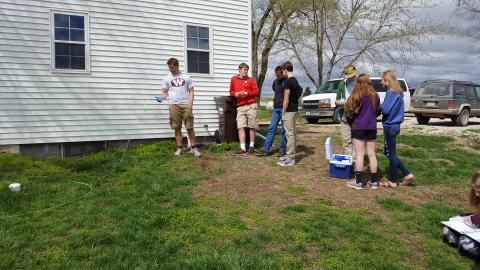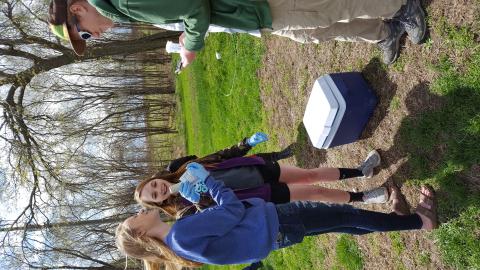By: Steve Ress
Students at Waverly High School, not far from Lincoln, were the among the first of what will be students from sixteen schools different across Nebraska to learn more about possible contaminants in their well water through a hands-on program called “Know your well” being conducted by the Water Sciences Laboratory at the University of Nebraska-Lincoln.
We want these students to learn about possible groundwater contaminants and how they can affect well water quality, how to test well water and learn differences between test kits and laboratory methods, said UNL graduate student Chris Olson who is managing the Nebraska Environmental Trust (NET) funded “Know your well” program at UNL.
“The project is about helping people understand what might be in their well water and how to sample and test groundwater samples. It’s about helping rural residents be informed consumers and replacing indifference or uncertainty with knowledge,” he said of the program that involves a consortium of UNL experts. The program is designed to train students in assessing the quality of drinking water derived from rural domestic wells. Ultimately it will involve science and agricultural education programs and FFA chapters at 16 Nebraska high schools Olson said.
The first to sample well water under the program were about a dozen students from Waverly High School, just a few miles northeast of Lincoln.
“We met with and accompanied teacher Kris Spath and her students on their first sampling expedition in early April,” said Dan Snow, director of the Water Sciences Laboratory (WSL) at UNL.
Spath is Waverly High’s agriculture teacher and FFA adviser, as well as a UNL IANR ag education alumni.
Other schools that will be conducting samplings this year include Newman Grove, Central City, Auburn and Filmore-Geneva High Schools, Snow said.
Over the three-year project, each participating school group will be given multiple test kits for measuring common water contaminants and will be provided with training needed to properly use all of the kits, Olson said.
A mobile app will be developed as part of the project to ease data entry and will be used directly by the students to upload data to an online database. Students will also provide information about well construction and land use from each of the wells sampled.
The results of student-tested water samples will be compared with analysis of samples collected by the students and analyzed by research technicians at the WSL, Snow said.
It’s important for students to learn both about well water quality, what factors can affect well water, and the wide variety of ways to measure and analyze groundwater contaminants, Olson said.
Most Nebraskans rely on groundwater drawn from wells for their drinking water and very few of domestic wells are regularly tested, he said, noting “Well testing can be an expensive, time-consuming and sometimes confusing process.”
“National surveys suggest that rural domestic wells may be susceptible to a variety of natural and synthetic contaminants. Some of these are potentially detrimental to health, such as bacteria, radon, arsenic, uranium, nitrate, fluoride, and pesticides such as atrazine,” Snow said.
Collected samples will be analyzed for a suite of pesticide residues, nitrate, metals, and dissolved minerals by staff at the WSL. Researchers will analyze the gathered land use data and the well testing results to determine whether certain land uses, well construction and aquifer characteristic have any relationship to well water quality. Annual workshops will be conducted at UNL to provide students and teachers with feedback on well test results, updates on methods, and provide interaction with UNL faculty and staff.
UNL faculty cooperating on the program in addition to Snow include Nebraska Water Center director Chittaranjan Ray, Ashok Samal of UNL’s Department of Computer Science and Engineering, and Matt Kreifels of UNL’s Department of Agricultural Leadership, Education and Communication.
Funding for the project, which began last year, is through a three-year grant from the Nebraska Environmental Trust.
The WSL and Nebraska Water Center are part of the Daugherty Water for Food Global Institute at the University of Nebraska.


